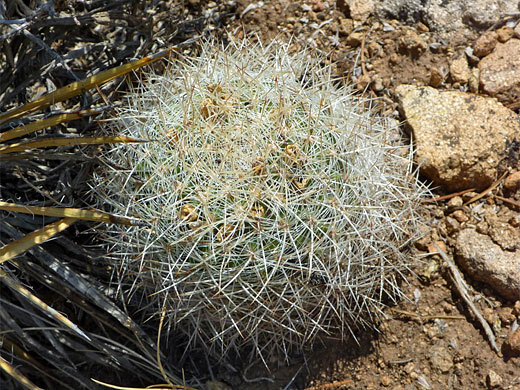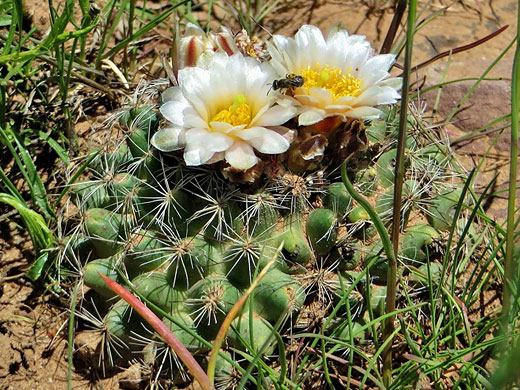Scientific name:
Pediocactus simpsonii
Common name:
Mountain ball cactus, Simpson's hedgehog cactus
Range:
The Rocky Mountains, from south Montana to north New Mexico; also scattered locations in Oregon, Nevada, Utah and Arizona
Form:
Globes or cylinders, usually single
Habitat:
Grassland, sagebrush flats, pinyon-juniper woodland; up to 11,000 feet elevation
Flowers:
Yellow at the center, white to pink around the edges

Distribution map for pediocactus simpsonii
Although pediocactus simpsonii has a wide geographic distribution, from Oregon and Montana south to Arizona and New Mexico, the cactus is still relatively uncommon, growing in high elevation locations, often in small, localized areas, frequently obscured by grass and fallen leaves. The plant may form clusters but usually remains solitary, starting as a neat globe, becoming elongated and cylindrical when aged (up to 10 inches tall).
The 15 to 35 white radial spines are thin and short, while the 4 to 11 central spines are thicker, longer (up to 3/4 inch), and brown or yellow at the tips; all grow from pronounced tubercles, arranged in spirals. Spine cover tends to be dense, nearly or completely obscuring the green stems, though in some specimens the spines are much shorter, and fewer in number.
The plant's appearance changes greatly in different locations, and several sub species have been proposed, but distinguishing features are so variable across the 900 mile range that precise identification is difficult.
The 15 to 35 white radial spines are thin and short, while the 4 to 11 central spines are thicker, longer (up to 3/4 inch), and brown or yellow at the tips; all grow from pronounced tubercles, arranged in spirals. Spine cover tends to be dense, nearly or completely obscuring the green stems, though in some specimens the spines are much shorter, and fewer in number.
The plant's appearance changes greatly in different locations, and several sub species have been proposed, but distinguishing features are so variable across the 900 mile range that precise identification is difficult.
All Contents © Copyright The American Southwest | Comments and Questions | Contribute | Affiliate Marketing Disclosure | Site Map





